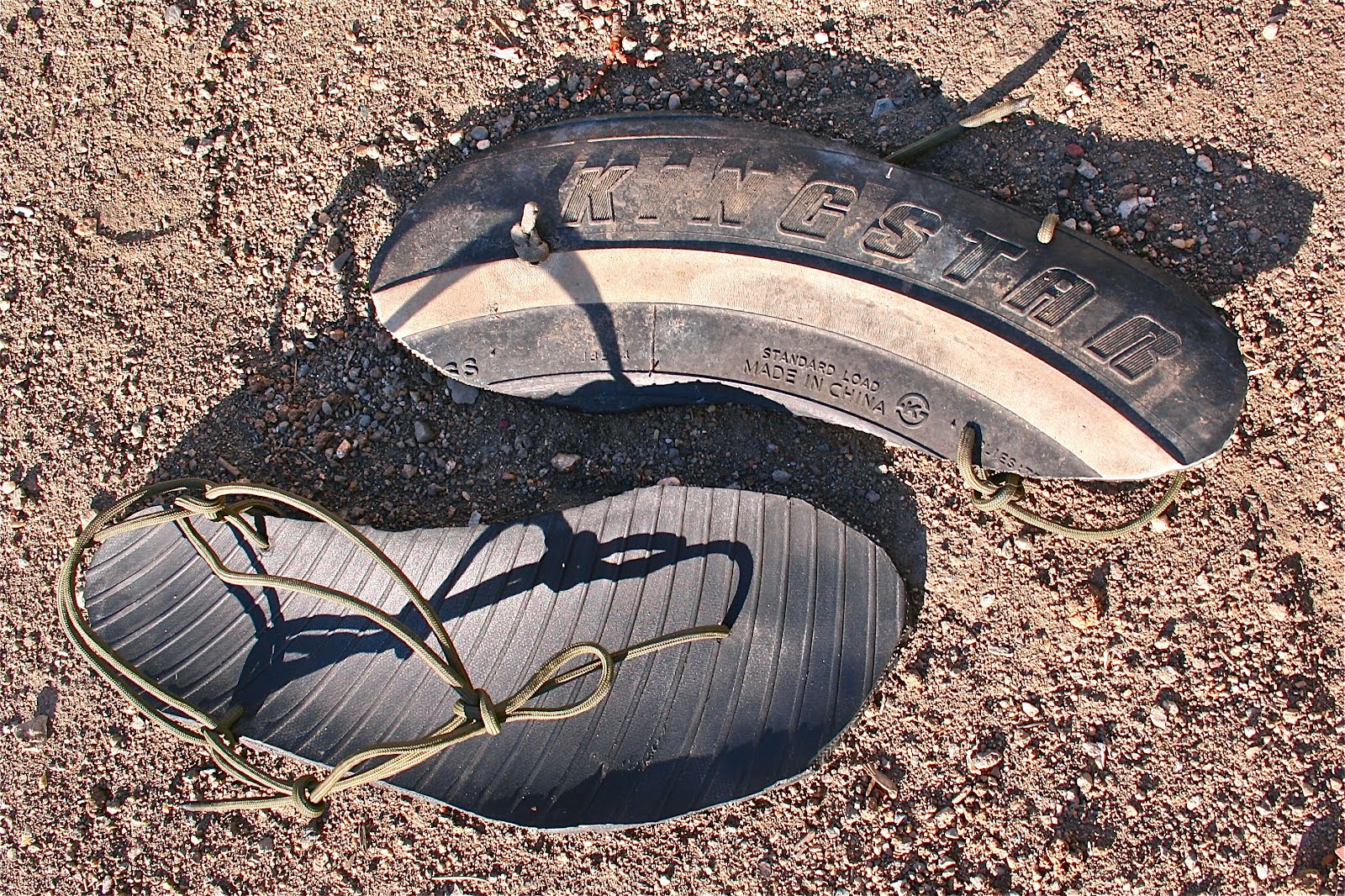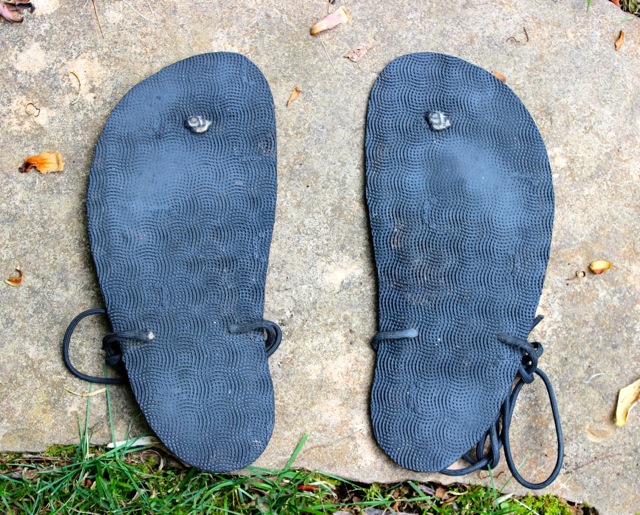I had a question on my personal YouTube channel about acclimating your feet to huaraches. So I am here to give you the good, the bad, and the ugly.
 If you are not familiar with Huaraches, they are the (tire) sandals of the Taramurhara Indians of northern Mexico. It’s also worth noting other cultures from around the world have used similar footwear from tires.
If you are not familiar with Huaraches, they are the (tire) sandals of the Taramurhara Indians of northern Mexico. It’s also worth noting other cultures from around the world have used similar footwear from tires.
As a forester, I had worn hiking boots for many, many years between work and personal woods time. I “freed me feet” with Chaco sandals for about 10 years acclimating them to cold simply by wearing year round. Even temperatures around freezing were not a problem unless the humidity was high. Their thick foot bed and sole, as I found out later, were an excellent insulator to the ground.
Several years ago, a couple things started frustrating me with Chacos. First, they are heavy and bulky, which only became worse when I started traveling by air for work, a true pain to fit in a backpack. I wanted to have alternative footwear with me always — finally, when Chaco moved their manufacturing from Colorado to China, I decided to look elsewhere.

Vibram Cherry Sole Material.
So on a whim, I bought a sheet of 4mm Vibram Cherry Sole on eBay and made a pair of huaraches learning from YouTube videos. There is a short learning curve in tying them and getting used to the knot under your big toe. I started off slow, walking the dog, a short walk here and there. What was originally going to be a pair of “shoes” to carry in an emergency, I started wearing more and more. When I went back to wear the Chacos, they felt like they weighed a ton and were unbearable. The huaraches ended up being all I wore. The acclimation process continued…
It didn’t take long, but I adjusted to the wider range of surface temperatures as again, the Chacos had insulated me very-well from those extremes. Interestingly, you learn more about your environment with these little temperature clues. Who’d thought astroturf gets so hot (coaching my son’s football team, yes in huaraches). More importantly though, my walk changed. I was no longer a heel-toe walker (see picture). Similar to a barefoot runner, now the front part of my foot came down first. NOT the heel.

Bottom soles of a pair of my huaraches. Note the wear towards the front and not the heel. I have always walked in these, not run.
Walking in this manner keeps your knees from locking-out completely. According to many sources on barefoot running, etc., this is an advantage to your body as your legs act like a shock absorber. By walking naturally, impacts on joints are reduced. As a fun test, take a walk in your bare feet as you would normally wearing shoes, but this time, put your fingers in your ears. Assuming you are a heel-toe walker, you will hear some pretty loud thuds from your body jarring on your locked-out joints. Now walk putting the front of your foot down first, it should be much quieter.

Heel-toe walker.
I like to watch people walk since I have gone through these revelations on the subject. Interestingly, as I mentioned walking naturally in the last paragraph; young children who haven’t worn shoes much, and girls/women who regularly wear flats, tend to walk more on the front of their feet. Start watching the way people walk and you will see what I mean. A person that wears cushioned sneakers is often a big-time heal-toe walker, their only saving grace the shoe’s thick cushioning. Watch a TV show highlighting a primitive culture who doesn’t wear shoes, and you will see that natural walk on the front of their foot like the young child.
Some Bad and Ugly (and more Good) from my experiences…
COLD WEATHER. I live in the southeast, with a humid-cold on pavement, I am only good down to the upper 30s, sometime 40s depending how I am feeling. I can usually go a little colder in the woodlands and in dry weather. I am forewarning you now, that if you go this route, finding comfortable footwear to match huaraches for winter has been a pain for me (see TRANSITIONING below). I have a pair of Lems Shoes sneakers which are good in the cold when its dry out, but wet-cold…
Back to the acclimatization question of how. It takes time to adjust is an obvious answer. But also understanding your physiology. Realize that your feet are the farthest from your heart, how hydration and what you consume dictates how your body handles the cold too. Not just carbs generating heat either, but other things you digest such as diuretics and vasoconstrictors which impact circulation are very important for your extremities. Also, I keep my middle and high-heat loss areas (head, neck, arm pits, groin) warm to help keep my feet warm. I also suggest you check out this video on using just wool socks in winter, nice to know in an emergency too.
AS A WATER SHOE. Huaraches don’t work well in moving water. Being flexible and connected in only three points, fast moving water will flip portions of the sole over. This reduces what little protection I have and could even trip you up, plus they sink. I cross slow moving streams in them all the time, no problem. If fact it is nice because you don’t have to worry about getting wet as they dry right away. However, when I paddle white water as an example, no thank you.
IN THE MOUNTAINS. They work great on uneven terrain. Walking along a slope, they contour to the terrain, so there is no rolling like in a shoe or boot. Going downhill there is no jamming into a toe box either. If the top (footbed) of the huaraches aren’t slick, your foot won’t slide into the straps like you might expect. Instead, your foot contours to the ground and sticks to the footbed.
BLISTERS. I have had zero problems with blisters and hotspots from the laces when tied with correct tension. Some footbed materials will get polished from grit in between your foot and the sandal. For me, I have to keep those areas roughed up or I get a hotspot. Some folks put a piece of leather on top of the rubber sole too. I switched to a better material and haven’t had a problem since (see end of article for material).
LONG DISTANCES. Walking long distances on uneven terrain is no problem (for me). Walking long distances on completely flat pavement, not fun. As an example, after a day at the amusement park with the kids, my feet were killing me. Relief only came from walking on uneven ground; cobblestones, brick, patches of grass which were like a little massage and I was glad to see those surfaces.
TRANSITIONING. It’s tough going back and forth from huaraches to ‘normal’ shoes. When I have to wear shoes, it kills my knees and feet. Not to mention, my feet have gotten wider which makes shoe selection harder. Plus, going back and forth from being open (breathing) to an enclosed shoe isn’t the greatest for your skin.
EMPOWERING. It is empowering to make your own footwear. Knowing how to tie them and the experience of walking in them the biggest part. Floor mats, carpet, a piece of tire, door mats, a piece of wood, etc., you will know how to improvise shoes in an emergency. They are also a great conversation piece… “Where did you get those sandals?” “I made them…” “Really?!?”
Suggestions / Final Thoughts
When I was buying the Vibram Soles, it cost me around $13 to make a pair of huaraches. I started and continue to use 550 paracord for the laces. I know other materials work better, but I buy the stuff 1,000′ at a time and have it stashed everywhere should I need it.
The Vibram Cherry Soles worked well, but didn’t last the longest. At less than $30 a pair, I now buy the DIY kit from XeroShoes. They developed a material that simply doesn’t wear out as quick — sole and footbed. In fact they offer a 5K mile warranty on them. I don’t want to make a commercial of this for XeroShoes, but this is what they do and they have good information, so I will link some of it below in case you are interested…
HOME TO MAKE 3 of 3 (tying)
There is much more information out there on how to make and how to tie tire sandals. If you go for the tire material, keep in mind, most automobile tires now have metal cords. Look to ATV/motorcycle tires, lawn tractor tires, golf cart tires, etc. Hope you enjoyed my perspective on huaraches.


3 Responses to Huaraches